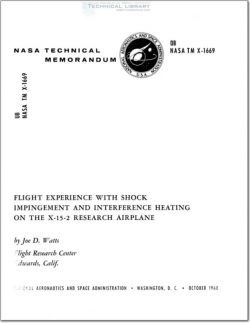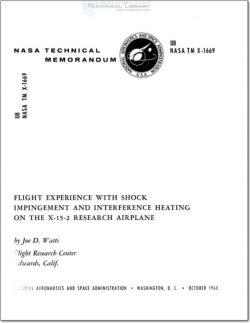NASA-TM-X-1669

- Version
- 111 Downloads
- 2.31 MB File Size
- 1 File Count
- June 15, 2016 Create Date
- June 15, 2016 Last Updated
Flight Experience with Shock Impingement and Interference Heating on the X-15-2 Research Airplane

ere structural melting damage due to complex shock impingement and inter—
ference effects on local aerodynamic heating was experienced on a flight of the X-15 -2
research airplane to a maximum Mach number of 6. 7. Measured flight temperature
data and observed structural damage resulting from shock impingement and interfer—
ence heating on the airplane and its ablative coating were analyzed in the light of
hypersonic wind—tunnel results. The best approximations of the flight results were
made by increasing the undisturbed pylon leading—edge heat—transfer coefficient by a
factor of 9 and the undisturbed heat—transfer coefficient in the two interference zones
by a factor of 7. The calculated effect of increased heat transfer due to interference
on radiation—equilibrium temperature is presented for selected hypersonic cruise
conditions.
One of the first experiences with actual severe structural damage on a hypersonic
aircraft due to a combination of shock impingement and interference effects on local
heat transfer occurred on a performance -envelope -expansion flight of the X-15—2
research airplane. The heating damage was near a dummy hypersonic ramjet engine
mounted on a pylon (modified ventral fin) at the rear end of the fuselage. The flight,
planned to test an ablative coating and evaluate the handling qualities of the airplane
with the dummy ramjet installed, reached a maximum Mach number of 6. 7 at an
altitude of 99,000 feet (30, 175 meters). This paper describes the preflight and post—
flight condition of the aircraft and dummy ramjet engine and the flight conditions. It
presents the measured temperature data and an analysis of the flight data made in the
light of available wind—tunnel data. The calculated structural radiation—equilibrium
temperatures associated with this type of heating condition at selected hypersonic
cruise conditions are included to emphasize the effect on radiation-cooled structures.
The flight configuration of the modified X—15—2 airplane is shown in figure 1, and
the preflight condition of the dummy ramjet engine and pylon is shown in figure 2. The
entire pylon and most of the dummy ramjet engine were coated with ablative material
for thermal protection. The conical flow—field probes shown in figure 2 were installed
to measure flow angularity and pressure levels in the ramjet intake area. The ablative
materials were the same as those used in the coating for the entire airplane, MA —255
sprayable silicone ablator on skin surfaces and BSA—3560 -IIA pre —m01ded silicone
ablator in stagnation areas (ref. 1). Figure 3 shows the ablative materials used and
the skin thicknesses in the pylon and ramjet—engine area.
| File | Action |
|---|---|
| NASA-TM-X-1669 Flight Experience with Shock Impingement and Interference Heating on the X-15-2 Research Airplane.pdf | Download |
Comment On This Post